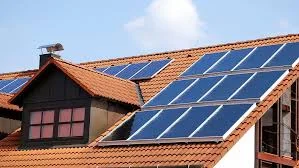Complete Guide to How Home Solar Power Works
Step 1: Sunlight activates the panels.
Rooftop solar panel arrays or rack-and-panel solar systems:
Each panel is made up of a layer of silicon cells, a metal frame, a glass casing covered by a protective coating, and wiring. To maximize effect, the panels are arranged in “arrays” (organized series) and set on rooftops or in vast outdoor places. Solar cells, commonly known as photovoltaic cells, absorb sunlight during daylight hours. This is how Solar Power Works.

Step 2: The cells generate electric current:
Silicon ingots and wafers:
Each solar cell contains a tiny semiconductor wafer comprised of two layers of silicon. One layer is positively charged, while the other is negatively charged, creating an electrical field. When light energy from the sun strikes a photovoltaic solar cell, it energizes it and causes electrons to be released from the atoms within the semiconductor wafer. The electric field surrounding the wafer causes those unbound electrons to move, which generates an electrical current.

Step 3: Electrical Energy is Converted:
A Solar Inverter:
You now have solar panels that efficiently convert sunshine into electricity, but the electricity created is known as direct current (or DC) electricity, as opposed to alternating current (or AC) electricity, which powers the majority of homes.
Fortunately, an inverter can simply convert DC electricity into AC electricity. In modern solar systems, these inverters can be set up as a single inverter for the entire system or as individual microinverters mounted behind the panels.

Step 4: The converted electricity powers your home.
A solar microinverter:
After being converted from DC electricity to AC electricity, the solar energy flows through your electrical panel and powers appliances throughout your home. Nothing in your home needs to be altered because it operates in the same manner as the grid-generated electricity provided by your utility company.

Step 5: A net meter measures usage.
A smart electrical meter
During overcast days and nights, your solar panels or cells may not receive sufficient sunshine to generate power. During the day, when no one is home, they generate an excess of energy, which is more than enough to power your house. This is why a meter is used to monitor the inflow and outflow of power from your home. If you ever push extra electricity back into the grid, your utility company will usually return you with a refund. This approach is known as net metering.

Conclusion
Now that you understand the fundamentals of solar energy, you may marvel at how modern photovoltaic technology can harness the tremendous power of the sun to power a home. It may not be rocket science, but it shows human creative thinking at its best.
Our blog section is a great place to go if you want to learn more about solar panels.
FAQ’s
How do solar panels work?
Solar panels, composed of PV cells, capture sunlight and transform it into electricity using the photovoltaic effect. When sunlight reaches the PV cells, photons knock electrons loose from atoms in the silicon cells, resulting in an electrical current.
What is a photovoltaic (PV) cell?
PV cells, often known as solar cells, are the fundamental components of solar panels. They are composed of semiconductor materials, typically silicon, that can conduct electricity when exposed to sunlight. When sunlight reaches the PV cells, it forms an electric field across the layers, which generates direct current (DC) electricity.
Does solar electricity function at night or on overcast days?
Solar power generation relies on sunshine; therefore, solar panels do not generate electricity at night. However, energy storage devices can store extra electricity generated during sunny hours for use at night or on overcast days, maintaining an ongoing power supply.
How is solar energy stored?
Solar energy can be stored with batteries or other energy storage systems additionally, excess electricity produced by solar panels during sunny hours can be stored in batteries for later use when sunshine is not available, such as at night or on cloudy days.


